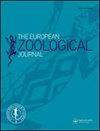Dissecting biodiversity: assessing the taxonomic, functional and phylogenetic structure of an insect metacommunity in a river network using morphological and metabarcoding data
IF 1.4
4区 生物学
Q2 ZOOLOGY
引用次数: 1
Abstract
Abstract Most empirical metacommunity studies rely solely on morphological identification of taxa, precluding the species-level identification of several biotic groups, which can influence the characterization of metacommunities. DNA metabarcoding enables inference of species and even intraspecific diversity from community samples but has rarely been used to infer metacommunity structure. Here, we combined morphology and metabarcoding to improve the characterization of an insect metacommunity at different identification levels. We included measures of taxonomic, functional and phylogenetic richness, and we evaluated drivers affecting metacommunity structure (i.e., environmental filtering and dispersal). Communities were sampled from an area that included nine perennial, two near-perennial and two intermittent sites in a river network characterized by high hydrological variability. We identified organisms to a mixed (family to species) taxonomic level using morphology, and to operational taxonomic unit (OTU) and haplotype levels using metabarcoding of the mitochondrial cytochrome c oxidase gene. Diptera and Ephemeroptera showed the greatest increases in taxonomic and phylogenetic richness but not biological trait richness with increasing taxonomic resolution. The joint effect of environmental filtering and dispersal was more important than their individual effects in shaping metacommunity structure at all identification levels. Mixed-level and OTU-level identification were more effective than family and haplotype in characterizing the drivers of metacommunity structure. We demonstrate that the greater taxonomic resolution enabled by metabarcoding could improve understanding of metacommunities within river networks, thus enhancing our capacity to predict ecological responses in ecosystems adapting to global change.解剖生物多样性:利用形态学和代谢条形码数据评估河网中昆虫元群落的分类、功能和系统发育结构
摘要大多数经验元群落研究仅依赖于分类群的形态学鉴定,排除了几个生物群的物种级鉴定,这可能会影响元群落的特征。DNA代谢编码能够从群落样本中推断物种甚至种内多样性,但很少用于推断元群落结构。在这里,我们将形态学和代谢编码相结合,以提高昆虫在不同鉴定水平上的元群落特征。我们包括分类学、功能和系统发育丰富度的测量,并评估了影响元群落结构(即环境过滤和扩散)的驱动因素。群落是从一个以高水文变异性为特征的河网中的九个多年生、两个近多年生和两个间歇性站点中取样的。我们使用形态学在混合(家族到物种)分类水平上鉴定生物体,并使用线粒体细胞色素c氧化酶基因的代谢编码在操作分类单元(OTU)和单倍型水平上鉴定生物。随着分类学分辨率的提高,翅目和蜉蝣目的分类学和系统发育丰富度增加最大,但生物特征丰富度没有增加。在所有识别水平上,环境过滤和扩散的联合效应比它们的个体效应在形成元群落结构方面更重要。混合水平和OTU水平的鉴定在表征元群落结构的驱动因素方面比家族和单倍型更有效。我们证明,元条形码能够实现更大的分类分辨率,可以提高对河网内元群落的理解,从而提高我们预测生态系统适应全球变化的生态反应的能力。
本文章由计算机程序翻译,如有差异,请以英文原文为准。
求助全文
约1分钟内获得全文
求助全文
来源期刊

European Zoological Journal
Agricultural and Biological Sciences-Animal Science and Zoology
CiteScore
3.10
自引率
5.60%
发文量
80
审稿时长
30 weeks
期刊介绍:
The European Zoological Journal (previously Italian Journal of Zoology) is an open access journal devoted to the study of all aspects of basic, comparative and applied protozoan and animal biology at molecular, cellular, tissue, organ, organismal, population, and community-ecosystem level. Papers covering multiple levels of organization and integrative approaches to study animal form, function, development, ecology, evolution and systematics are welcome. First established in 1930 under the name of Il Bollettino di Zoologia, the journal now has an international focus, reflected through its global editorial board, and wide author and readership.
 求助内容:
求助内容: 应助结果提醒方式:
应助结果提醒方式:


